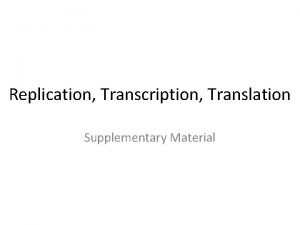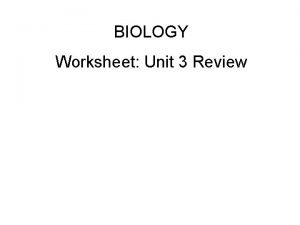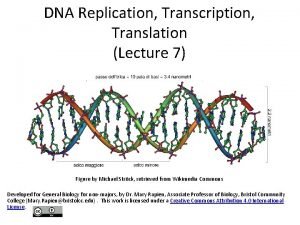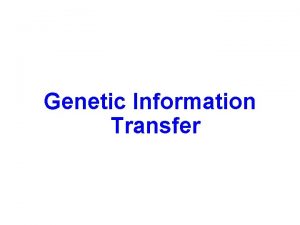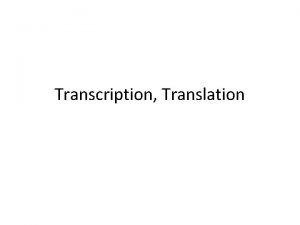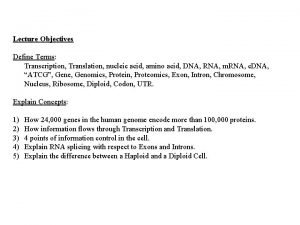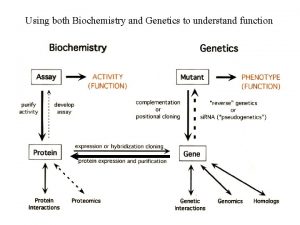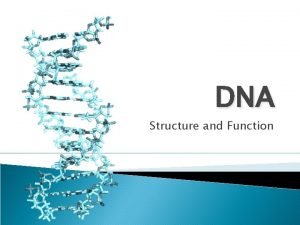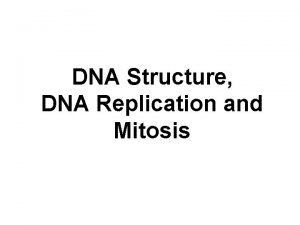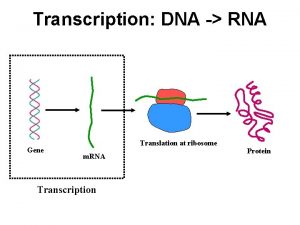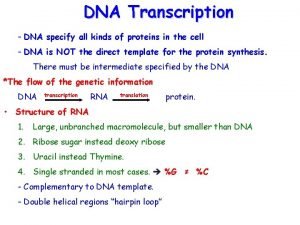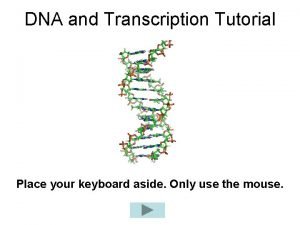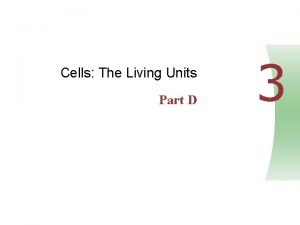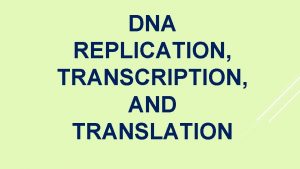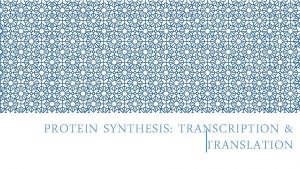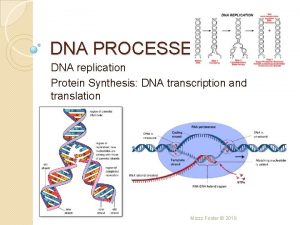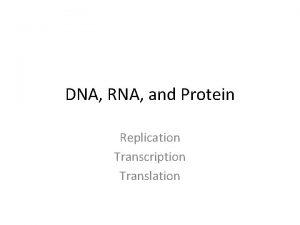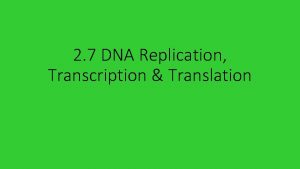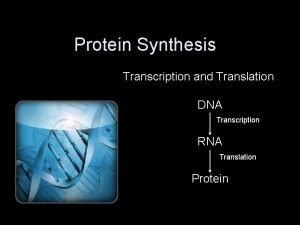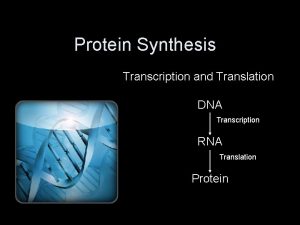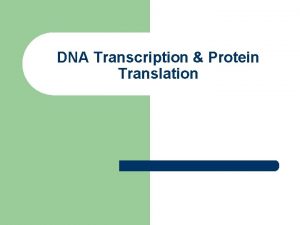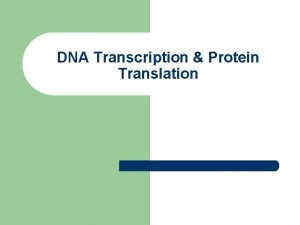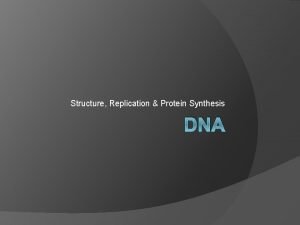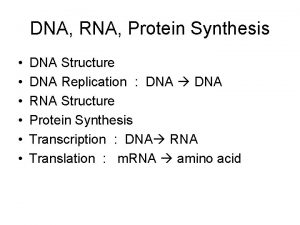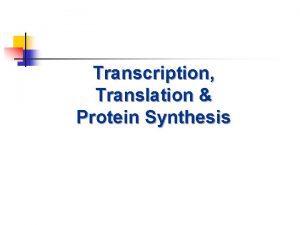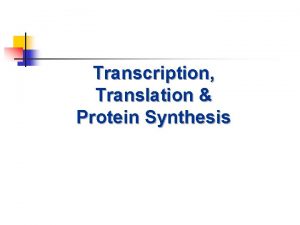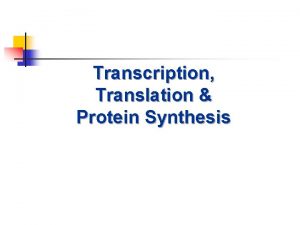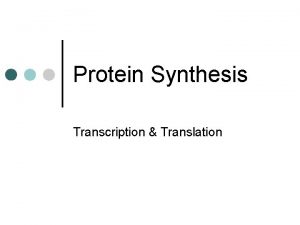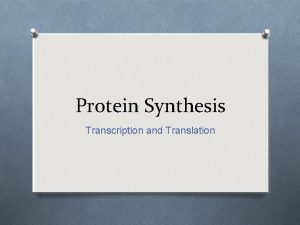Protein Synthesis Replication Transcription Translation DNA Structure Discovered






















- Slides: 22

Protein Synthesis Replication, Transcription, Translation

DNA Structure • Discovered by? ? – Crick, Watson and – Rosalind Franklin

Where is DNA? DNA from 1 Chromosome may be 1 meter long or more!

DNA Shape • • Nitrogen bases Double Helix Rung: nitrogen bases held together by hydrogen bond Complimentary pairs – A-T and C-G Hydrogen bond

DNA shape, con’t • Rail – Ribbon of phosphate and sugar – Rungs attached to sugar (deoxyribose)

Replication • When does this happen? – S phase of mitosis (after checkpoint) • Why does this happen? – preparation for mitosis • How does it happen? – DNA bings to unzip at H-bonds – Free nucleotides (in nucleus) begin to attach to exposed bases (enzymes assist) – Bins to make 2 new strands (exact replicas of the first)

Background before Protein Synthesis • DNA controls cell function • DNA instructs cell to make enzymes & other proteins • Proteins composed of amino acids • DNA codes for amino acid production • 3 bases = 1 amino acid (3 bases called a “triplet” • Bases are like the alphabet used to make words

Background, con’t 64 sets of bases code for 20 amino acids. Sequence of bases codes for a sequense of amino acids which makes a protein

Protein Synthesis - Characters t. RNA m. RNA

Protein Synthesis Characters – con’t r. RNA become ribosomes

Transcription – DNA makes RNA • Occurs in the Nucleus • Process – DNA unzips – Free complementary nucleotides attach to DNA • Nucleotides contain ribose NOT deoxyribose – – – Nucleotides attach only to ONE side of DNA When RNA complete, it releases from DNA zips back up RNA is EXACT complement of DNA m. RNA triplets are called Codons m. RNA migrates out of nucleus to ribosomes where protein synthesis occurs

Transcription (Hyperlink)

Transcription – amino acids can be predicted based on CODONS

Transcription game

Translation • RNA codes for Amino Acid chain which becomes a protein • m. RNA attaches to Ribosome • t. RNA is in cytoplasm near ribosome

Translation (hyperlink), con’t • Anticodons match up to codons on m. RNA causing amino acids to line up • Covalent bonds (peptide bonds) form between amino acids • When bond formed –trna is released to go get another amino acid • Ribosome moves down m. RNA to next set of codons and “reads” it • Sequence continues till an entire protein is made • As many as 80 amino acids may be linked per minute

Mutations- 3 kinds Replaced base pair, Lost base pair, Additional base pair

Mutations, con’t What is this one?

Results of mutations

Causes of mutations • Pollution • Radiation • Chemicals

Mutations also cause disease • Sickle Cell Anemia - glutamic acid replaced by valine – caused abnormal hemoglobin (red blood cells)

Lots of places for protein synthesis to go wrong
 Chapter 11 dna and genes
Chapter 11 dna and genes Dna replication transcription and translation
Dna replication transcription and translation Bioflix activity dna replication nucleotide pairing
Bioflix activity dna replication nucleotide pairing Transcription translation replication
Transcription translation replication Transcription translation replication
Transcription translation replication Dna meaning
Dna meaning Replication
Replication Transcription end result
Transcription end result Dna transcription and translation
Dna transcription and translation Dna synthesis at replication fork
Dna synthesis at replication fork Replication
Replication Rna and protein synthesis study guide
Rna and protein synthesis study guide Translate
Translate What is a human genome
What is a human genome Acids and bases venn diagram
Acids and bases venn diagram Forms of dna
Forms of dna Multiple choice questions on dna structure and replication
Multiple choice questions on dna structure and replication Dna structure and replication
Dna structure and replication Dna to rna transcription
Dna to rna transcription Dna transcription
Dna transcription Dna and transcription tutorial
Dna and transcription tutorial Dna transcription
Dna transcription Dna to rna transcription
Dna to rna transcription



